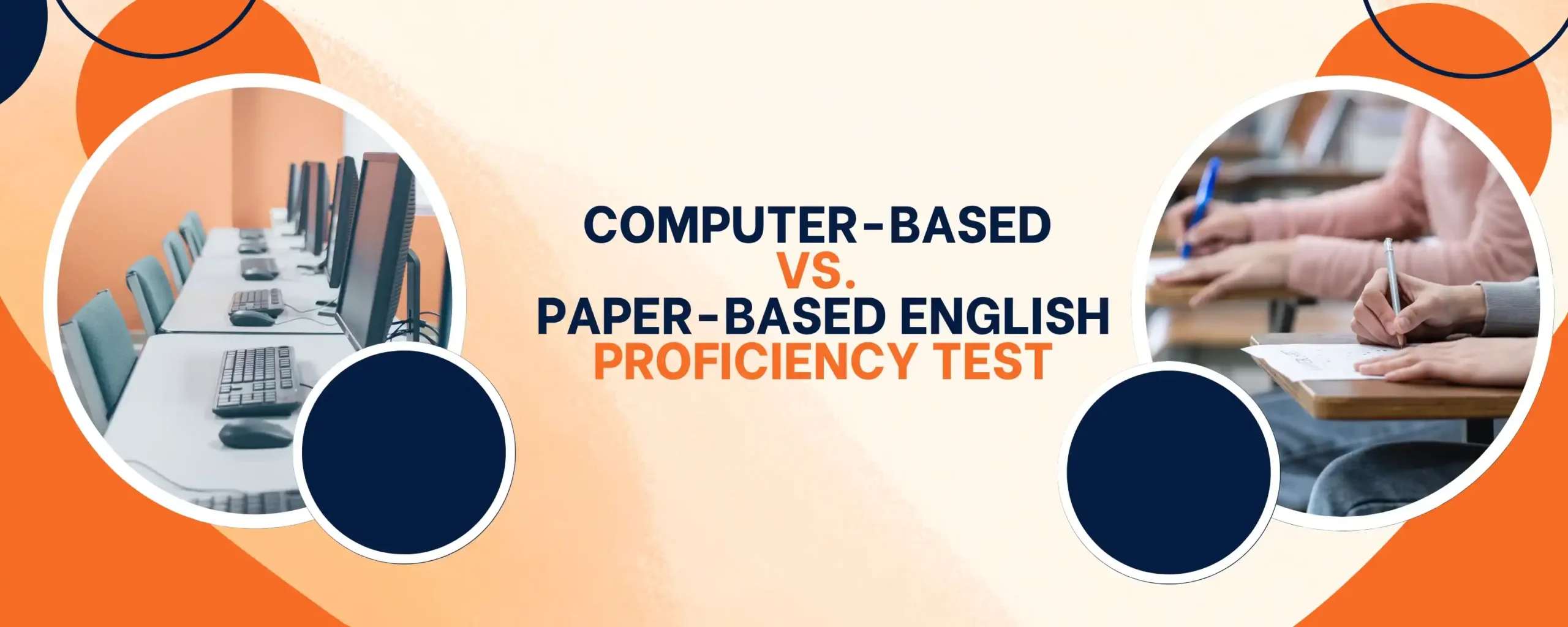In today’s increasingly digital world, we often face the choice between familiar traditional methods and newer technological approaches. This conundrum also extends to English proficiency tests like IELTS, PTE, and TOEFL, which are crucial for pursuing global academic dreams and career aspirations. These standardized exams are essential for showcasing your English language skills. Keeping up with the technological revolution, these tests are now offered in both paper-based and computer-based formats. But which test format is better for you? Let’s find out!
Understanding Paper-Based and Computer-Based English Tests
On one hand, a paper-based test is considered the traditional exam format. For this version of exams, you are provided with a physical test booklet with questions and separate answer sheets. For listening, reading, and multiple-choice sections, you are supposed to mark answers or fill in bubbles in the provided sheets. For writing tasks, you manually write your responses. Scoring for all sections typically involves human examiners, resulting in longer result processing times.
On the other hand, a computer-based test involves taking the exam on a computer. Questions are displayed on screen, and you are supposed to type your answers directly. While the speaking component usually remains a face-to-face interview with an examiner (for IELTS), other sections benefit from automated scoring, contributing to faster result delivery. Common English proficiency tests like IELTS, TOEFL, and PTE Academic offer both paper as well as computer-based versions!
Key Differences Between Paper-Based & Computer-Based Tests
| Key Feature | Paper-Based Test | Computer-Based Test |
| Test Environment | Traditional exam hall setting.Writing answers with pen/pencil in physical booklets.May involve distractions from other test-takers’ writing noises. | Dedicated workstation with a computer, headphones, and microphone.Typing answers on a keyboard.Can offer more privacy with partitions. |
| Time Management | Less strict timer visibility, requiring self-pacing throughout the test. | System guides you through sections, offering less free movement between tasks and therefore less control over pacing. |
| Scoring Process | Manual scoring by human examiners, especially for writing and speaking.Potential for slight human bias in subjective sections. | Automated scoring for Listening and Reading. Faster results due to a combination of automation and human scoring. |
| Flexibility & Test Dates | Fewer test dates per month due to logistical requirements for physical materials and examiners.Limited slot availability. | More frequent test dates and times, often several times a week.Increased flexibility in booking slots, especially in developed cities and centres in India. |
Advantages of Paper-Based English Proficiency Tests
Like each coin has 2 sides, here are some advantages of paper-based format of English proficiency tests:
- Ideal for individuals who are more comfortable and used to handwriting their responses.
- Eliminates uncontrollable issues such as screen fatigue, software malfunctions, or internet connectivity problems.
- Suited for individuals who prefer conventional learning approaches, like the ability to physically hold the test paper in their hands, tick the questions attempted, circle the questions still left to answer etc.
Advantages of Computer-Based English Proficiency Tests
While paper-based tests offer certain advantages, here are some advantages of computer-based English proficiency tests that cannot be ignored:
- Computer-based formats, particularly for tests like PTE and the computer-delivered IELTS, often provide results relatively quicker than their paper-based versions. This can be a major advantage for individuals with closer application deadlines.
- Many individuals prefer typing to writing their responses. This can be because they are considerably faster in typing. Typing answers also reduces the risk of your handwriting not being legible to the examiner! Computer-based tests also make edits more easily within the allotted time.
- Tests using automated scoring, like PTE Academic, offer a higher degree of objectivity. This can reduce human bias in the assessment, providing a more impartial evaluation of language proficiency
Who Should Choose Which Test Format?
Both versions of such standardised tests have their own benefits – then how will you choose the test format for you?
If you are someone who:
- is not comfortable typing quickly or prefers to handwrite responses
- prefers a traditional test setting of an examination hall as well as the experience of marking answers on physical paper
- is susceptible to screen fatigue or anxiety about potential technical glitches during an exam
then Paper-Based Tests are your go-to!
However, if you:
- have shaky penmanship
- are tech-savvy and can type faster and more accurately than you can write!
- would prefer a substantially quicker result delivery due to closer application deadlines
- are comfortable with navigating digital interfaces and utilising on-screen tools like timers and word counters
then Computer-Based Tests are for you!
Your personal learning styles and preferences can be a significant factor that affects this choice. You must consider which version of the test will align best with your typical study behaviour, ability to perform under pressure to maximize your scores!
How to Prepare for Your Chosen Test Format?
One thing you must be tired of hearing by now is “Effective preparation is key”. But effective preparation can differ from format to format! What might help you during a paper-based test might not help during a computer-based test!
For paper-based exams:
- practicing handwritten essays under timed conditions can help you to improve speed and legibility.
- using printed mock tests can aid in familiarizing yourself with the layout!
For computer-based exams:
- practice typing your responses to enhance your typing speed and accuracy.
- make use of free online digital mock tests and online practice platforms to simulate the actual test conditions like on-screen timers to become more comfortable navigating on-screen questions.
If you’re looking for structured preparation for either format, check out expert-led courses at La Forêt Education to boost your success rate!
Final Verdict: Which One is Better?
There’s no one-size fits all in this case! Remember that the ideal format is entirely dependent on your individual preferences and strengths. Before making your decision, you must carefully consider your typing speed versus handwriting speed and legibility. Your comfort level with digital interface versus physical test papers must also be considered! Carefully check the availability of test centers for each format in your location. By carefully analysing and weighing these factors, you can make an informed choice that aligns with your testing style and maximise your potential for success!
Conclusion
Choosing the perfect English proficiency test format is crucial for success. While both paper-based and computer-based options offer distinct advantages based on your comfort with technology, typing speed, and preferred test environment. Before booking, you must not only assess your strengths, but also weaknesses in relation to each format. This process will help you select the method that best aligns with your testing style, ensuring you can perform at your peak and manage the exam conditions most effectively. Whichever format you choose, remember that preparation is key to achieving your desired score!
Frequently Asked Questions
1. Which IELTS test is better, computer-based or paper-based?
Ans: Neither format is inherently “better”! The choice depends on one’s personal comfort with typing versus handwriting, preferred test environment, and how quickly you need your results. For example, someone who requires their proficiency test results quicker might prefer a computer-based test, while an individual who has relatively far-off application deadlines and is comfortable with either typing or writing
2. Which English proficiency test is widely accepted?
Ans: IELTS and TOEFL are the most popular and widely accepted proficiency tests, globally accepted by thousands of universities, organizations, and immigration authorities.





